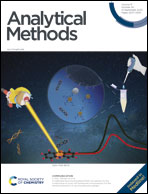Enzyme-free and sensitive method for single-stranded nucleic acid detection based on CHA and HCR†
Abstract
Simple, rapid, and highly sensitive methods for single-stranded nucleic acid detection are of great significance in clinical testing. Meanwhile, common methods are inseparable from the participation of enzymes, which greatly increases their complexity. Herein, an enzyme-free and sensitive method combining HCR and CHA is established to detect single-stranded nucleic acid. A target induces the auxiliary hairpin strands to open their secondary structure, exposing partial sequences that can trigger catalytic hairpin assembly (CHA) and hybridization chain reactions (HCR), respectively. To avoid additional signaling substances, 2-aminopurines (which fluoresces differently in double-stranded DNA and G-quadruplex) are modified in the substrate chains of CHA and HCR. Compared with methods that adopt CHA or HCR alone, the sensitivity of this method is increased by nearly 10 times. Moreover, this method can effectively improve the specific recognition of the target. To “turn on” the method, two regions that can pair with H5 and H6 are required. Taking foot-and-mouth disease virus (FMDV) as the object, this method can specifically detect FMDV to 2.78 × 101 TCID50. Although the sensitivity is not as good as RT-qPCR, it owns the advantages of simplicity and speed. We think this method can be used for the primary screening of FMDV, and has application potential in some grassroots.



 Please wait while we load your content...
Please wait while we load your content...